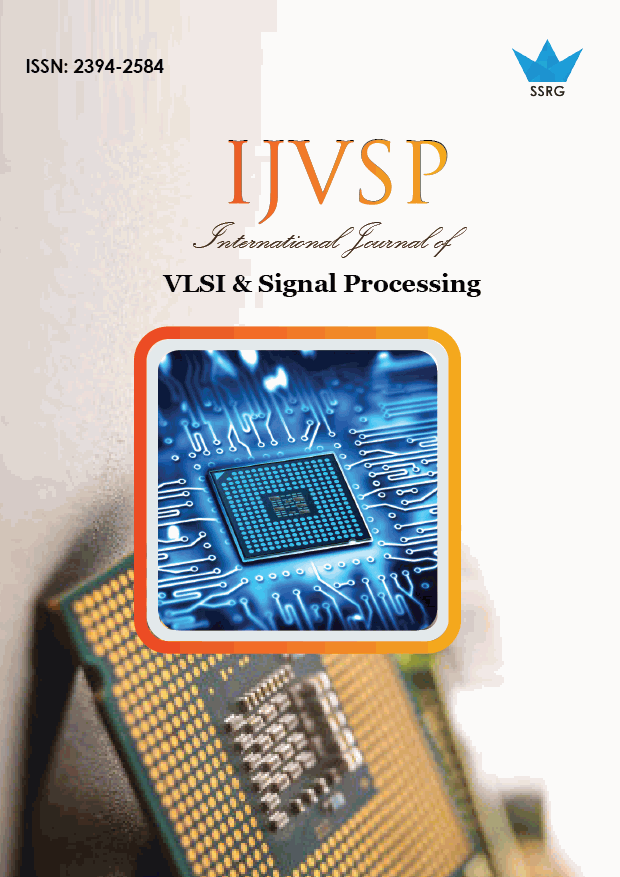Reducing the Computation Time in Two’s Complement Multipliers

| International Journal of VLSI & Signal Processing |
| © 2015 by SSRG - IJVSP Journal |
| Volume 2 Issue 3 |
| Year of Publication : 2015 |
| Authors : A. Hari Priya |
How to Cite?
A. Hari Priya, "Reducing the Computation Time in Two’s Complement Multipliers," SSRG International Journal of VLSI & Signal Processing, vol. 2, no. 3, pp. 13-17, 2015. Crossref, https://doi.org/10.14445/23942584/IJVSP-V2I3P103
Abstract:
To reduce the area of partial product array size and improve the speed which is generated by a radix-4Modified Booth Encoded Multiplier is used. This reduction is possible without any increase in the delay of the partialproduct generation stage. This reduction provides faster compression of the partial product array and regular layoutsin two’s complement multiplier. The proposed method is that the Radix-4 (Fixed-Width) Modified Booth Multipliersare used to achieve the low power and increase the speed by modifying the partial product matrix size. The Multiplierdesign implemented using Xilinx. The results based on a rough theoretical analysis and on logic synthesis showed itsefficiency in terms of both area and delay. It is compared with Radix-4 (short bit-width) Modified booth encoded Multiplier.
Keywords:
Multiplication, Modified Booth encoding, partial product array.
References:
[1] J.-Y. Kang and J.-L. Gaudiot, “A Simple High- Speed Multiplier Design,” IEEE Trans. Computers, vol. 55, no. 10, pp. 1253-1258, Oct.2006.
[2] E.M. Schwarz, R.M. Averill III, and L.J. Sigal, “A Radix-8 CMOS S/390 Multiplier,” Proc. 13th IEEE Symp. Computer Arithmetic, pp. 2- 9, 1997. [3] W.-C. Yeh and C.-W. Jen, “High-Speed Booth Encoded Parallel Multiplier Design,” IEEE Trans. Computers, vol. 49, no. 7, pp. 692-701, July 2000.
[4] Z. Huang and M.D. Ercegovac, “High- Performance Low-Power Left-to-Right Array Multiplier Design,” IEEE Trans. Computers, vol. 54, no. 3, pp. 272-283, Mar. 2005.
[5] R. Zimmermann and D.Q. Tran, “Optimized Synthesis of Sum-of-Products,” Proc. Conf. Record of the 37th Asilomar Conf. Signals, Systems and Computers, vol. 1, pp. 867-872, 2003.
[6] V.G. Oklobdzija, D. Villeger, and S.S. Liu, “A Method for Speed Optimized Partial Product Reduction and Generation of Fast Parallel Multipliers Using an Algorithmic Approach,” IEEE Trans. Computers, vol. 45, no. 3, pp. 294-306, Mar. 1996.
[7] P.F. Stelling, C.U. Martel, V.G. Oklobdzija, and R. Ravi, “Optimal Circuits for Parallel Multipliers,” IEEE Trans. Computers, vol. 47, no. 3, pp. 273-285, Mar. 1998.
[8] R. Hashemian and C.P. Chen, “A New Parallel Technique for Design of Decrement/Increment and Two’s Complement Circuits,” Proc. 34th Midwest Symp. Circuits and Systems, vol. 2, pp. 887-890, 1991.

 10.14445/23942584/IJVSP-V2I3P103
10.14445/23942584/IJVSP-V2I3P103